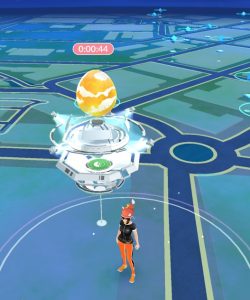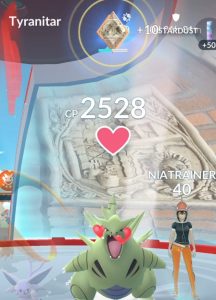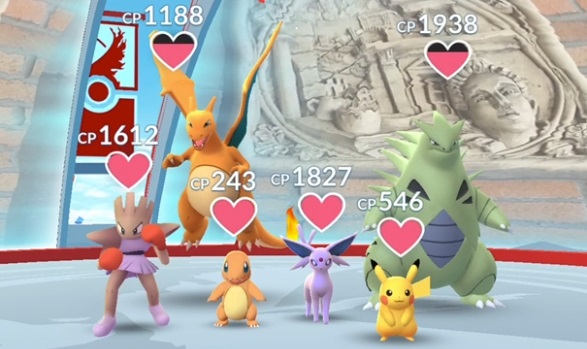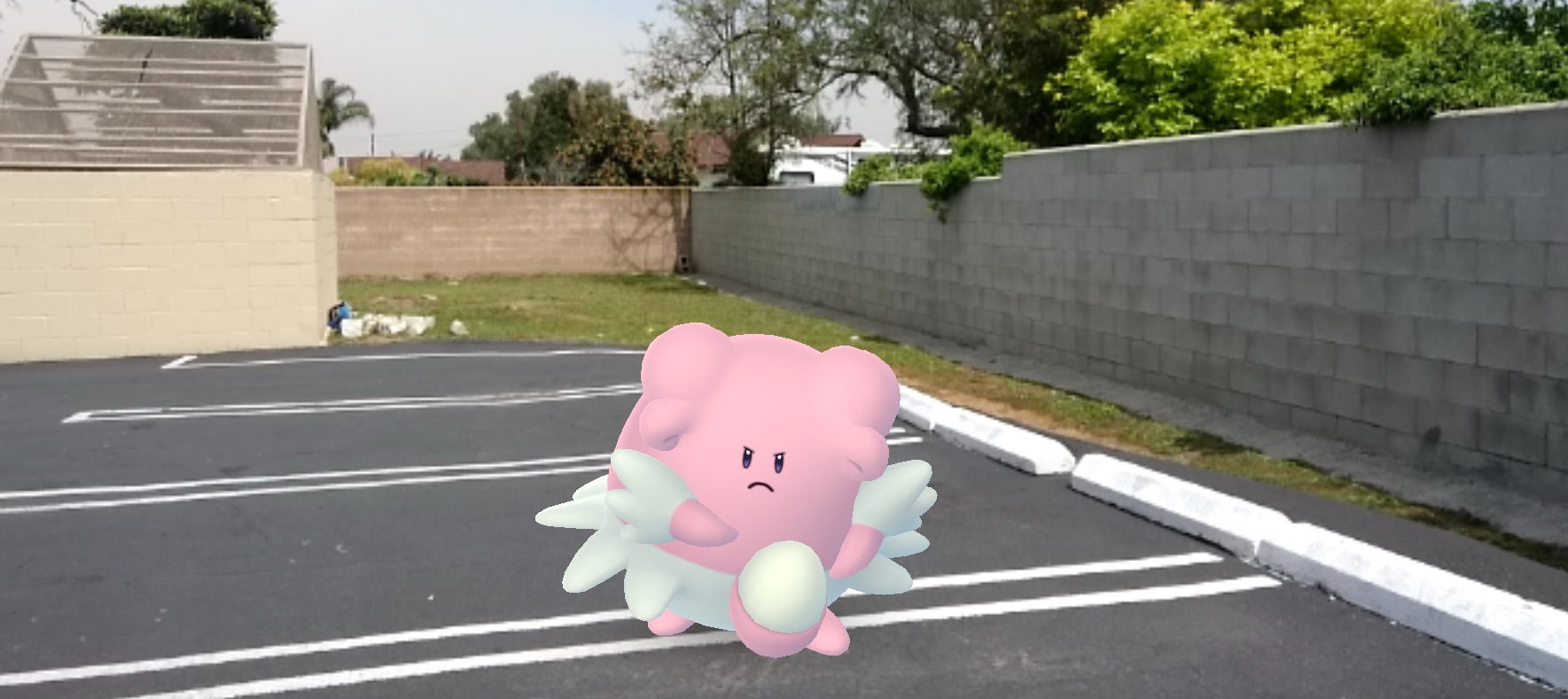
Surprise! Niantic brought Pokemon Go to E3 2017 and invited members of the gaming press outside the sacred halls of the Los Angeles Convention Center to check out the upcoming raid system at a nearby gym. We were granted not just some juicy details on upcoming changes but a rare chance to interview several key members of the team, including Senior Product Manager Tatsuo Nomura, Global Product Marketing Lead Archit Bhargava, and a bit of time with Niantic Director of Engineering Edward Wu.
Perhaps more so than the Generation 2 update, summer feels like it’s bringing an expansion-like update to the free to play game.
PokeRaiders
There are so many new additions and changes coming out this summer, but let’s start with raiding. We’ve known from data mining that it’d be coming and correctly guessed that it’s the Mewtwo event seen in the game’s original trailer. Raid Battles are the new cooperative play option that Niantic’s been teasing, allowing up to 20 people per room to fight the same randomized Poke-boss for a chance to catch a (significantly depowered) version of it. Don’t worry about that cap, as multiple raid rooms exist publicly, and people can also raid privately if they wish. This is a great feature for busy gyms where you want to ensure that you’re with your friends, and it uses an adorable password system made up of different Pokemon. As a more rural player, I do worry about attempting raids solo as some people from out of town privately take down the boss from the safety of their car, but I’m hopeful that the new addition will bring more good than bad to my local scene.
Raids activate at gyms (which are closed during the raid period), giving bonuses to the team that currently hold them should a member of that team help defeat the boss. There’s a large timer above the gym indicating how long until the raid opens, but the frequency of raids is something Niantic is apparently still working on. While the timer is counting down, you’ll see a giant egg over the gym, which will hatch into the boss players can battle.
There’s an entry fee of one Raid Pass, which we were originally told were from PokeStops but actually come from Gyms, which now also act as PokeStops to help rural players out a bit. This is interesting because a player had some evidence that the Pokemon Go+ peripheral was allowing him to get items from the gym. Nomura wasn’t aware of this and felt it must have been a mistake. Either through gyms or stops, you can pick up multiple passes per day, according to the information given us during the event, but again, it’s confusing as a post-event mailer tells us that you can hold only one ticket at a time and buy a Premium Raid Pass with gold from the in-game store.
It’s important to note that even if you don’t defeat the raid boss, you can still enter and try again, but players only have five minutes to beat it. You’re still allowed 6 Pokemon, and with about five of us playing, the boss went down rather easily, with my loaner Tyranitar still at about 50% health with a CP of about 2.2k. The takeaway here is that it’s relevant for lapsed players and accessible for casuals.
 However, don’t expect the bosses to be all Mewtwos and Articunos. Niantic wouldn’t go into detail about which Pokemon would be bosses but did said they probably won’t be Caterpies and Magikarp. At my demo, we saw Snorlax, Charizard, and Chansey as potential bosses. Since then, I’ve also seen assets showing off Gengar and Tyranitar as well.
However, don’t expect the bosses to be all Mewtwos and Articunos. Niantic wouldn’t go into detail about which Pokemon would be bosses but did said they probably won’t be Caterpies and Magikarp. At my demo, we saw Snorlax, Charizard, and Chansey as potential bosses. Since then, I’ve also seen assets showing off Gengar and Tyranitar as well.
That being said, Niantic did say it would be handing out passwords to those who were very active in the gym system to give them a chance at catching legendary Pokemon at a later date. For one, this means you should probably make sure you have access to the email account you registered the game with. However, it also means that you shouldn’t feel pressure to go to the Pokemon Go Fests announced earlier this month. Bhargava assured us that those events are meant to help people meet like-minded players in a social environment, similar to the recent Ingress event, not to have their one and only shot at Mewtwo.
Our raid boss demo was pretty enlightening. First, the boss ‘mon are massively boosted. There was a Charizard with 13k CP, but a player’s Charizard can’t even reach 2.7k CP at the moment. There isn’t any major changes in combat in terms of basic play, so if you thought swipe, tap, and charge would go away, you’ll be disappointed. That being said, something felt different. For example, generating enough energy for my charge attack felt slower than usual, and my demo’mon was the same as a Pokemon I use semi-frequently when playing the game myself (Tyranitar with Bite/Fireblast).
Depending on performance, gym affiliation, and maybe some other factors (which we’ll discuss shortly), you’ll naturally pick up some rewards. The first multiple chances to catch the boss in a depowered, normal CP range state, but like Pokemon from eggs, they will be stronger than average in terms of the game’s hidden stats (IVs). No, this doesn’t mean five chances to catch a Boss Blissey means five Blisseys, just that Blissey can run away but you can still catch it in another try. Bosses are tough to catch, though. It seemed like I was the only one able to catch our boss without it running away after the first attempt.
Don’t worry if you’re short on balls, because you’re supplied some premier balls for the event, but still have access to at least your berries. I say this because among the other gyms rewards is the new “Golden Razz Berries” that help make capturing even easier than the standard Razz.
It’s not all about catching strong Pokemon though. There were a few other rewards I wasn’t expecting. The first was Rare Candy, something Niantic wouldn’t discuss at E3 but revealed in a media mailer. Rare Candy become whatever candy you need by using them on the Pokemon of your choice. More surprising, however, were the Technical Machines (TMs) we’d earned, a feature players had asked about but I honestly hadn’t expected, figuring Breeding would be implemented and rolled out with Trading to fulfill a specific niche. Currently, Pokemon wi wouldn’t explain exactly what they do, but I’d suggest holding onto your high IV Pokemon.
Currently, Pokemon with good stats and a good moveset is rare. I’ve mentioned that another, younger Nintendo mobile game elegantly solved this in a pretty fun way, but Niantic’s solution still makes sense. The follow-up media mailer indicates that using a Fast Attack or Charged Attack TM will teach a Pokemon a new, random Fast or Charged attack. It’ll be interesting to see what if any effect this has on Pokemon in relation to retired (or “Legacy”) abilities.
While all this sounds cool, there is a bit of a downside: We found out from the media mailer that Raids will be rolled out as a beta at first, only visible to high level players at sponsored locations. More players will be added to the system, but during this time, Niantic will “temporarily [disable] all Gyms. Once the update has been rolled out to players around the world, Gyms will return.” I’m not sure whether that means Gyms will return as content while high levels test the Raids or they’ll be unavailable until everyone can Raid, but this is an important note to factor as gyms are getting massive changes.
Working out gyms
Niantic says its been listening to player input and has revamped gyms based on that. In a lot of ways, this seems true. Pokemon Go has a lot of casual players, and they will especially benefit from the new system. Rather than having potentially 10 Pokemon in a single gym achieved through fighting your own team’s ‘mon to level up the structure, simply taking over the gym will allow your team to place 6 Pokemon inside. No more prestiging, period. Also, each Pokemon has to be unique. No more Blissey armies or stacking Rhydons. And that’s just the tip of the diversity innovations.
Pokemon in gyms now have “Motivation”; as Pokemon assigned to the gym lose battles (and as time naturally passes), they’ll lose motivation and (temporarily) CP so as to make them easier to defeat. When the ‘mon hit zero motivation, they leave the gym and return to their trainer.
To keep a Pokemon in the gym, anyone from the same side can give a Pokemon berries. I’m not sure what all the exact effects for each berry are, but we were told the Golden Razz Berries will fully restore a ‘mon’s motivation. Feeding berries gives you some star dust too, but coins come only from having your Pokemon in the Gym. However, the battle order is oldest to newest, meaning if you work hard to take out a gym and put your Blastoise in first, it will be the first Pokemon other players will fight, increasing its chance to also be the first Pokemon removed.
There are other systems at play, such as powerful and high-level Pokemon losing motivation faster than low CP and low-level Pokemon. I can imagine that Chansey might, in some way, be better than Blissey after the update, but your guess is as good as mine, as we weren’t given a gym demo. We were, however, originally told that raids only temporarily closed off a gym, but our media mailers now say the Pokemon in that gym will be sent home.
The new changes do a few things. For one, they make it more difficult to have multiple Pokemon stay for long periods of time in multiple gyms. This means that even in rural areas, the competition to keep your ‘mon in is going to increase. Gym “shaving” is an issue within the current meta, where people on the same team use a second account of a different team to take out the bottom Pokemon so as to put their own in. Nomura emphasizes that having a second account is not allowed under the TOS, but Niantic seems slow to respond to this, as my local scene has several people doing this in at least two teams.
That being said, this system, in theory, increases the amount of viable Pokemon, or at least will change them up, and the game needs that. While not being able to keep my Pokemon in gyms for sometimes weeks during a slow time in the game hurts my personal ability to get free coins, it may help renew interest in the game. We still don’t have specifics on combat though, and the combination of multiple systems changing and being added at once could result in a kind of SWG NGE experience or a FFXIV 2.0/ESO One Tamriel type update. We’ll just have to wait and see how things play out.
Back to badges
 One of the things that really stood out in terms of the game’s immersion (beyond AR issues) was that there were so many local gyms and no badge system, a Pokemon series staple. Niantic’s gone back and rectified this: Each gym will now have its own badge. Badges are essentially reputation, which is lame in most MMO terms but seems really cool for a real world mechanic. Unlike in an MMO, people generally don’t constantly keep moving, so grinding reputation with multiple, far flung, disjointed organizations makes little sense, but developing a rep with places you’re going to daily is, well, natural.
One of the things that really stood out in terms of the game’s immersion (beyond AR issues) was that there were so many local gyms and no badge system, a Pokemon series staple. Niantic’s gone back and rectified this: Each gym will now have its own badge. Badges are essentially reputation, which is lame in most MMO terms but seems really cool for a real world mechanic. Unlike in an MMO, people generally don’t constantly keep moving, so grinding reputation with multiple, far flung, disjointed organizations makes little sense, but developing a rep with places you’re going to daily is, well, natural.
An issue I’ve always had with PoGO is that people from out of town can sweep through my city and really mess up the scene, especially spoofers taking over the government-protected area we can legitimately access for only a few hours each month. With this change, however, locals literally have a home team advantage. Anyone who battles at a gym or feeds the Pokemon there will gain progress with that gym’s badge, and higher badge ranks mean at least better rewards from those specific gyms.
Not only should this help motivate people to stay active in their most local scenes, but when combined with raids, it will hopefully increase the chance to meet fellow local players, which is exactly why I got into this game in the first place. Not only that, but I personally like how this system helps address safety, as people will want to focus on building up gyms they know and live near.
There are a few concerns — bad neighborhoods are still an issue — but we’ve also seen popular suicide spots become less popular for that reason because gamers now visit them, so it might be nice if the same could become true of locations known for crime. The change from 10 to 6 ‘mon per gym may actually cause some people to go into new areas searching for easy gyms to take out, but again, the raid system getting people to visit these locales may help increase safety. The only thing I’m sure I’m safe to worry about is how crowded the badge screen might get for people in big cities or those of us who travel and play in multiple areas.
Rival mystery
As part of the B-roll press package, we received a short movie labeled “New Gym Rival Battle.” The audio isn’t important, but the short clip shows a player clicking on a gym with a Slowbro at the top, much like the highest CP Pokemon currently is at the top of a gym. The player then chooses “Go Battle” on the team selection area where we see that the “opponents” (the gym?) are a Venasuar (184 CP), Slowbro (384 CP), and Girafarig (1185 CP). Notice how the Slowbro is representing the gym but doesn’t have the highest or lowest CP. Then a screen similar to the one above appears but features the Venasuar before loading the actual gym fight against the Venasaur.
It’s difficult to judge the meaning of this clip. It could just be for flare. I don’t think it gives us an opportunity to change ‘mon between battles because, from the background conversation, the clip is unedited and never shows an opportunity to change Pokemon. I hesitate to suggest it, but I wonder if it may be some sort of PvP system, perhaps matching you against players who run into frequently at gyms, and hence the “rival” part of the title. Again, this was something Niantic shared with us after E3 and hasn’t discussed since. While we wait for their response, consider it open season, theorycrafters!
Update: As other sites have published the footage, Niantic’s PR has given us permission to share the clip as well. Thanks to PokemonGOHub.com!
Interview
The demo was absolutely packed full of updates other press seemed to barely comprehend in terms of significance, but let’s be honest: Pokemon Go’s popularity has waned, even if its still raking in absurd amounts of money. The majority of Niantic’s interviews are with general news and tech sites, with only the rare mainstream gaming site getting a sit-down, but we were offered the rare opportunity to talk with the Niantic people for a few minutes, and we’re considering that a positive sign for the studio. Though the team is slowly starting to communicate more with fans, there’s obviously some hurt from negative social media. I’m hoping, however, that the team is starting to see that engaging the community and press is the best way to help clear up misconceptions.
For example, despite Nomura himself being one of the Niantic team members referring or comparing the game to MMOs, the company seems to want to back off from this label. They admit that the resemblance to an MMO is strong and makes for good comparison, but there’s concern it makes people think of World of Warcraft, a game certain team members compared the game to themselves. At the moment, Niantic wants to emphasize the local, real life nature of their game. Why MMLG (Massively Multiplayer Local Game) isn’t enough, I’m not sure, but I feel validated in my rant about the game not being online enough to warrant the MMO title. It still possesses qualities I think many MMO players can appreciate, especially in terms of community power, but it’s a beast that’s inherited several MMO problems and possibly exacerbated some due to the reality-based nature of the game.
Critical as I may be, I do have to relent that talking with the team revealed a point I hadn’t previously noted: Not even one Pokemon Go event directly involves increasing gold rewards from the game. Bhargava mentioned that events, in-game and out, are supposed to encourage social play, not competitive play. While we report on a lot of shootings, thefts, deaths, and lawsuits, not one has been about two angry players attacking each other. Most are between players and non-players. Bhargava thinks that the emphasis on social play like exercise and simple problem solving, such as finding rare Pokemon, helps to keep tensions lower than, say, territory control in hardcore, item-drop-on-death PvP games. People may wander off cliffs and into traffic, but we’ve yet to see a legitimately dangerous Pokemon-based gang.
Trust in the players is also why Niantic doesn’t seem overly concerned with moral and ethical responsibilities in terms of player safety. The company cares enough to provide warnings, but as local players presumably know their neighborhoods better than Niantic, they’re better at policing themselves than the company could hope to be, which is fairly true for anyone playing in familiar spaces.
The team also wanted to emphasize that Niantic doesn’t actually work with Nintendo; it works with the Pokemon Company. Bhargava and Nomura insisted that no one side is responsible for gameplay features and that new additions are brought up at their weekly meetings and ping-ponged between the two companies to see what sticks and what doesn’t. That being said, Bhargava mentioned that the team uses Ingress as their R&D project, which isn’t entirely surprising. As it’s their own IP and has been around much longer than PoGO, it’s easier for Niantic to experiment with Ingress first before deciding if a system will work in PoGO.
There were no specific stories about rejected Pokemon hats or Ingress cross-over events, but the team did say it’s looking into social media integration. Niantic recognizes that most of its playerbase is made up of millennials who don’t exactly play games or interact with communities the way old school gamers did. Of course, the question is how fast Niantic can catch up with their consumers. The studio’s community manager is more of a behind the scenes guy, but hopefully this will change in the future as they move beyond tech help and slowly towards communication.
Although there’s some good public information about it, Niantic reps didn’t want to discuss the AR Playground some iOS developers received in their ARKit Pokémon GO tech demo. They were willing to discuss only what they revealed in their own blog post. That being said, Nomura said that the way AR has been implemented “is not optimal” and that they’re hoping their work with Apple will help them push things into a more AR friendly direction.
With little time left and no chance to speak with a programmer or designer, I had to ask what games (besides Ingress or PoGO) were currently popular with the team, so as to get some sort of hint about games that may be inspiring the team. Instantly I was told it was Zelda: Breath of the Wild, which one team member was representing with a small pin that day. Considering the exploration nature of both games, I shouldn’t be too surprised, but I do hope it’ll help inspire them. Perhaps forging in Hyrule will help motivate them to add berry cultivation and cooking to their game!

















